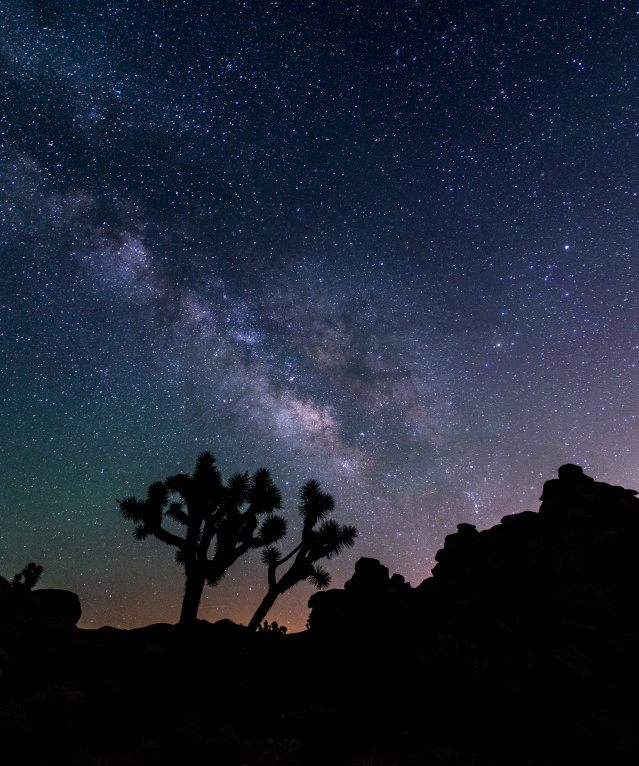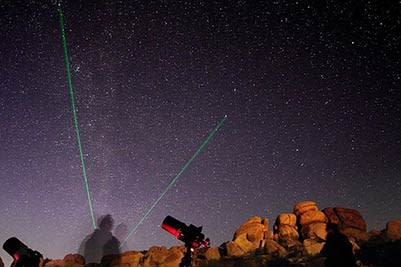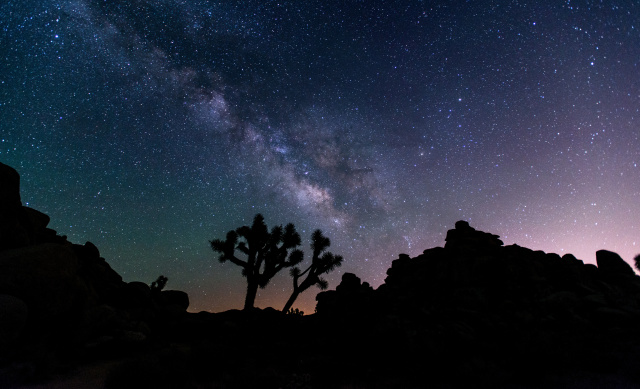Stargazing
PLANNING YOUR NIGHT UNDER THE STARS

Spending a night beneath under the stars is something you'll remember for your entire life. When visiting Twentynine Palms, you’ll have access to world-class stargazing within minutes of your stay — no matter what time of the year you visit. Finding dark skies will always be the most important factor to your stargazing experience, but it’s followed by a number of other important details to make sure your trip is a success. So, whether you’re looking for Orion, the hunter, or hoping to see the galactic core of the Milky Way for the first time, here's everything you need to know in order to make your Twentynine Palms stargazing adventure an unforgettable experience!
Basics of Stargazing
Location: Whether or not a location is suitable for stargazing will largely be determined by the amount of light pollution. When staying in Twentynine Palms, you’ll be just minutes from Joshua Tree National Park, which was designated as an International Dark Sky Park in 2017. Not only does that mean the area has a minimal amount of light pollution, it means it is protected from lights that are harmful to stargazing.
 In addition to visiting a place with minimal light pollution, gaining a bit of elevation will help, too! Good air quality ensures the stars shine brightly in the night sky looks.
In addition to visiting a place with minimal light pollution, gaining a bit of elevation will help, too! Good air quality ensures the stars shine brightly in the night sky looks.
Moon phase: Determining the phase of the Moon ahead of your visit will help make sure you see the most stars possible or even catch an incredible desert Moonrise.
So, what impact will different Moon phases have? Visiting on or around the New Moon will mean the skies will be at their absolute darkest and allow for the greatest number of stars to be visible. The days leading up to and following the New Moon are normally the best for stargazing as there will be time, or the entire night, without any Moon light washing out the stars.
Visiting during a Full Moon might mean less stars in the sky, but allows for some unique and exciting experiences of its own. You can start by catching Moon rise over the desert and if close enough to a Full Moon, take a carefully planned night hike.
You can visit this site (timeanddate.com) to determine what the Moon phase will be near or use free Android or iOS apps that will track the Moon phase for you!
Year-round Stargazing – What’s Visible?
One of the most exciting parts about stargazing is that the night sky changes throughout the year. That means visiting a spot and looking East in December will be different than standing in that same location and looking East in June!
Here are just a few highlights worth looking for throughout the year:
Winter:
Ursids Meteor Shower
Quadrantids Meteor Shower
Zodiacal Light (after dusk)
Orion
Gemini
Spring:
Lyrids Meteor Shower
Eta Aquarids Meteor Shower
Return of the Milky Way Core
Leo
Bootes
Hydra
Summer:
Dela Aquarids Meteor Shower
Perseids Meteor Shower
Zodiacal Light (before dawn)
Milky Way Core
Lyra
Scorpius
Fall:
Draconids Meteor Shower
Southern Taurids Meteor Shower
Northern Taurids Meteor Shower
Leonids Meteor Shower
Andromeda
Pisces
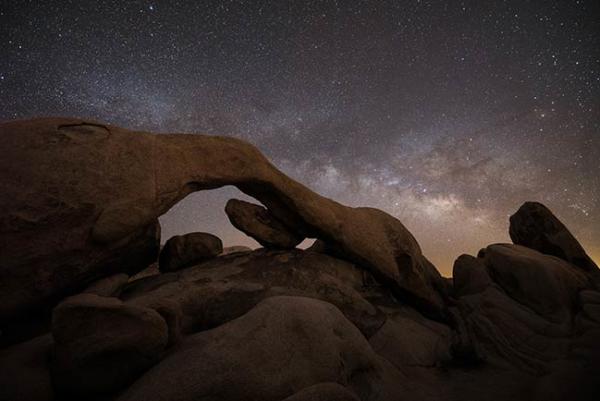 How to Plan for Each Season
How to Plan for Each Season
Visiting the desert for the first time can be an incredible experience and visiting at night can make it even more special. Although these locations are very accessible, they require special considerations to make sure you stay safe throughout your trip.
Fall / Winter:
Despite the challenge of dealing with the cold, these can be some of the best months for stargazing. Although we normally think of deserts as hot and dry, the conditions can often be quite the opposite in the Fall and Winter months. Temperatures can reach near freezing and it is not uncommon for the high desert to receive rain or snow in the colder months. Experiencing these conditions can make for a unique trip when properly prepared.
It’s important to check weather conditions before you enter the park or any wilderness area to avoid surprises. It’s better to plan on not having cell service as this will be the case in many locations. Dressing in layers is the easiest way to help regulate your body temperature. Multiple layers are also more effective at keeping you warm during cold, windy conditions.
It’s good practice to let someone know where you plan on visiting and when you plan on returning.
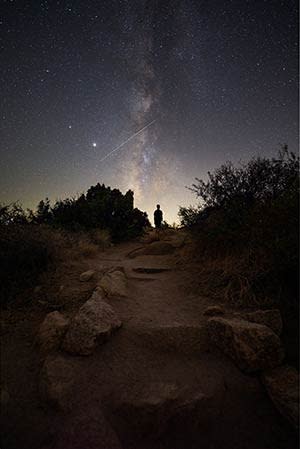 Spring / Summer:
Spring / Summer:
Some of the most exciting objects in the night sky are best visible in the Spring and Summer months. That means planning and being prepared to deal with increasingly warm weather as the seasons progress.
A first time visit to the desert during the warm season at night can be surprising. It’s easy to under estimate the effects of the heat at night. It can be helpful to drink plenty of water starting a few days before your time in the desert. While you’re there, it’s especially important to always have enough to stay hydrated, even at night. A gallon per day/per person is recommended.
Similar to visiting in the Fall/Winter, be sure to check the weather before entering and let someone know your planned location. You can help avoid activity in the heat by doing your scouting at the early morning or late evening.
Best Stargazing Applications
Whether you’re spending your first night under the stars or a seasoned stargazing, there are a number of apps you can use to help both before you head out and while you’re under the stars. Available for both iOS and Android devices it’s worth checking them out!
These apps will give an augmented reality view of what’s the in sky and also allow you to change the date for future planning!
Sky Walk – iOS/Android // Skyview – iOS/Android // Sky Safari – iOS/Android // ISS Spotter – iOS/Android
Photographing the Stars Checklist & Example Settings
Camera with full manual controls – You’ll need to pick all your settings manually, so it’s important to have complete control of your camera
Fast Wide-Angle Lens – Using a lens that is 24mm or wider and has a aperture of f/4 or faster will allow you to capture a huge view of the sky and the most stars possible!
Sturdy Tripod – Since you’ll be taking long exposures, you will want to ensure you camera stays steady the entire time.
Extra Batteries & Memory Cards – Colder temperatures at night tend to drain camera batteries quicker. Be sure to have backups and extra memory cards for all the photos you’ll be taking!
Red Headlamp – The red light will help you navigate the dark while keeping your night vision intact.
Although settings will vary depending on your specific equipment and by both location and astronomical conditions, use these settings as a guide to get started:
Exposure: 10-30 Seconds
Aperture: f4 or faster
ISO: 1600-3200
White Balance: Daylight
Focus: Infinity
File Format: RAW
Taking photos of the stars has a bit of a learning curve to it, so make sure to review your photos closely! Mostly importantly, don’t forget to look up in between exposures and enjoy the endless sea of stars!
Stargazing and Astronomy Experiences and Local Guides
TWENTYNINE PALMS ASTRONOMY CLUB
Whatever time of year you plan your visit to 29 Palms and Joshua Tree National Park, the 29 Palms Astronomy Club is ready to bring the epic grandeur of the night sky to you, from the comfort and privacy of your campsite, hotel, vacation rental, or place of residence! The 29 Palms Astronomy Club offers private night sky presentations, led by expert passionate astronomers who provide fun and interactive cosmic tours of the stunning night sky with high-powered telescopes, providing you with the opportunity to experience the night sky the way it was meant to be seen.
Adding a star party with the 29 Palms Astronomy Club to your travel itinerary is a sure way to make your experience in the Mojave Desert an unforgettable one. Interested in night sky photography? The 29 Palms Astronomy Club also offers private astrophotography lessons to teach you how to capture the vastness of the cosmos. Contact the 29 Palms Astronomy Club to learn more and book your next private night sky experience today!

SKY’S THE LIMIT OBSERVATORY & NATURE CENTER
There’s no better place in 29 Palms to spend the evening under the stars than at Sky’s The Limit Observatory and Nature Center! Ranked by AAA as one of the Best Destinations in the West for stargazing and astronomy, and sharing a border with Joshua Tree National Park – designated an International Dark Sky Park by the International Dark Sky Association in 2017 – Sky’s The Limit Observatory and Nature Center 15-acre campus features an observatory dome that houses a 14” Celestron Schmidt-Cassegrain telescope, an Orrery representing a true to scale and position model of the Solar System at 20 billion to 1, a solar calendar/sundial that marks the hours as well as the solstices and equinoxes, plus a Meditation garden based on Zen design principles, and a beautiful nature trail that showcases 33 native annuals, perennials, and cacti. Sky's The Limit Observatory is currently offering one night sky program each month, on the Saturday nearest the new moon when the sky is darkest and you can see the most stars and deep-sky objects. Be sure to register in advance for these monthly events as parking and capacity is limited.
In addition to these public programs, Sky’s The Limit also works in cooperation with Joshua Tree National Park to host the annual Night Sky Festival, which welcomes stargazers from across the US and around the world. This fun and educational event includes exhibits, activities, and presentations, ending with an awesome star party featuring live music, constellation tours, and the opportunity to meet 20 astronomers and look through their impressive telescopes. www.nightskyfestival.org/

Joshua Tree Astronomy Adventures
Joshua Tree Astronomy Adventures offers nightly stargazing tours inside Joshua Tree National Park. Whether you're a seasoned astronomer or a curious novice, our tours provide a memorable journey through the universe. Owned and operated by the guides who lead your tours, JTAA provides expert insights and breathtaking views of celestial wonders like planets, nebulae, star clusters, and distant galaxies. Utilizing state-of-the-art telescopes and laser pointers, we build a fun, engaging, and educational experience. The High Desert night sky is unforgettable. Join us under the stars in one of the world’s premier stargazing destinations! Book your tour at www.jtreeastronomy.com and call (760)636-8568 with any questions.
